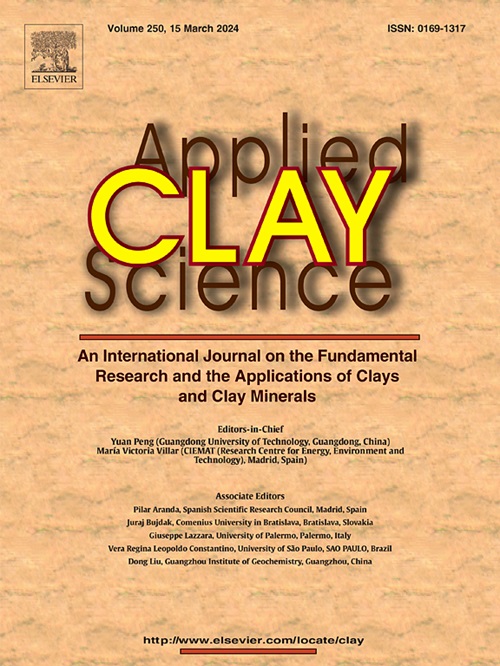Development of eco-friendly ceramic tiles incorporating sugarcane bagasse ash
IF 5.8
2区 地球科学
Q2 CHEMISTRY, PHYSICAL
引用次数: 0
Abstract
Industrial waste has become one of the most serious problems facing society. Its improper disposal leads to environmental degradation and contamination of water sources and soil. However, this waste can also contribute to a more environmentally friendly brick industry, as the incorporation of fluxing improves the firing process and reduces the thermal conductivity of fired bricks by reducing the induced porosity. The aim of this work is to use sugarcane bagasse ash residue as an alternative low-cost additive in proportions of up to 10 % by mass together with a local raw material used in the production of ceramic tile type BIIb. The samples were analyzed individually via analytical techniques to describe their physicochemical properties and the microstructural characteristics of porosity and densification. The characterization results revealed that the clay consisted mainly of the minerals quartz (51.7 %), muscovite (13.9 %), feldspar (9.8 %), hematite (5.8 %) and calcite (2.7 %) and the clay minerals montmorillonite (4.8 %) and kaolinite (10.6 %), whereas the residue consisted entirely of quartz (72.9 %) and cristobalite (27.0 %). The incorporation of sugarcane bagasse ash residues into the clay used in the production of ceramic tiles up to 10 % by weight does not compromise the properties of the final product (type BIIa, BIIb and BIII), in addition to resulting in a more sustainable and economical process for the industry, providing excellent technical properties in terms of strength, linear shrinkage and water absorption, because this result was achieved only when fluxes in the natural clay mass used in porcelain tile were replaced. These results will help minimize the cost of the final disposal of waste from the ceramics sector, reduce the environmental impact and increase the value of ceramic tiles as sustainable byproducts.
甘蔗甘蔗渣灰环保型瓷砖的研制
工业废物已成为社会面临的最严重问题之一。处置不当会导致环境恶化,水源和土壤受到污染。然而,这种废物也可以为更环保的砖工业做出贡献,因为熔剂的掺入改善了烧制过程,并通过减少诱导孔隙率降低了烧制砖的导热性。这项工作的目的是使用甘蔗甘蔗渣渣作为一种替代的低成本添加剂,其质量比例高达10%,与当地用于生产BIIb型瓷砖的原料一起使用。通过分析技术对样品进行了单独分析,描述了它们的物理化学性质以及孔隙和致密化的微观结构特征。表征结果表明,黏土矿物主要为石英(51.7%)、白云母(13.9%)、长石(9.8%)、赤铁矿(5.8%)、方解石(2.7%),黏土矿物为蒙脱石(4.8%)、高岭石(10.6%),剩余部分主要为石英(72.9%)、方解石(27.0%)。在瓷砖生产中使用的粘土中掺入高达10%重量的蔗渣渣渣,不仅不会影响最终产品(BIIa, BIIb和BIII型)的性能,而且还为该行业带来了更可持续和更经济的过程,在强度,线性收缩率和吸水率方面提供了出色的技术性能。因为这一结果只有在替换了用于瓷砖的天然粘土块中的助熔剂后才能实现。这些结果将有助于最大限度地减少陶瓷行业废物的最终处理成本,减少对环境的影响,并增加瓷砖作为可持续副产品的价值。
本文章由计算机程序翻译,如有差异,请以英文原文为准。
求助全文
约1分钟内获得全文
求助全文
来源期刊

Applied Clay Science
地学-矿物学
CiteScore
10.30
自引率
10.70%
发文量
289
审稿时长
39 days
期刊介绍:
Applied Clay Science aims to be an international journal attracting high quality scientific papers on clays and clay minerals, including research papers, reviews, and technical notes. The journal covers typical subjects of Fundamental and Applied Clay Science such as:
• Synthesis and purification
• Structural, crystallographic and mineralogical properties of clays and clay minerals
• Thermal properties of clays and clay minerals
• Physico-chemical properties including i) surface and interface properties; ii) thermodynamic properties; iii) mechanical properties
• Interaction with water, with polar and apolar molecules
• Colloidal properties and rheology
• Adsorption, Intercalation, Ionic exchange
• Genesis and deposits of clay minerals
• Geology and geochemistry of clays
• Modification of clays and clay minerals properties by thermal and physical treatments
• Modification by chemical treatments with organic and inorganic molecules(organoclays, pillared clays)
• Modification by biological microorganisms. etc...
 求助内容:
求助内容: 应助结果提醒方式:
应助结果提醒方式:


